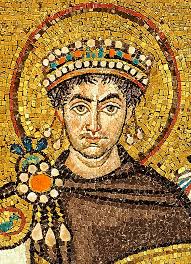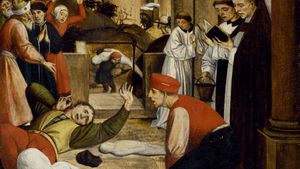Difference between revisions of "How Did the Plague of Justinian Change History"
(→Historical Impact) |
(→The Key Events) |
||
| Line 3: | Line 3: | ||
==The Key Events== | ==The Key Events== | ||
| − | To our knowledge, the bacterium that caused the Justinian Plague (Figure 1) is <i>Yersinia pestis</i>, which is still found in the mountains of Tian Shan, which sit along the modern Kyrgyzstan, Kazakhstan, and China borders. This is a form of bubonic plague, very similar to the Black Death. While today the plague from this bacteria can be treated, periodic outbreaks would have likely devastated ancient populations without any known immunity. The spread of the plague could have had many reasons, but it could have been migrating travels from Central Asia, including possibly Huns, may have spread the plague. This was also a period of relatively cold winters and failed crops may have prompted migrations that brought the plague with travelers. The Silk Road was also an important trading network during the 6th century CE, suggesting travelers from Central Asia probably brought it to the eastern Mediterranean, where it then also spread into Europe from these Mediterranean ports. There is also evidence that the plague came through North Africa, as important trading ports connected Africa with eastern Asia. From Ethiopia, and into Egypt, the plague could have also expanded into the Middle East and into Europe. Both historical descriptions of the symptoms and excavated skeletons with evidence of the plague that date to this period suggest the plague, similar to the 14th century Black Death, was the culprit. | + | To our knowledge, the bacterium that caused the Justinian Plague (Figure 1) is <i>Yersinia pestis</i>, which is still found in the mountains of Tian Shan, which sit along the modern Kyrgyzstan, Kazakhstan, and China borders. This is a form of bubonic plague, very similar to the Black Death. While today the plague from this bacteria can be treated, periodic outbreaks would have likely devastated ancient populations without any known immunity. The spread of the plague could have had many reasons, but it could have been migrating travels from Central Asia, including possibly Huns, may have spread the plague. This was also a period of relatively cold winters and failed crops may have prompted migrations that brought the plague with travelers. The Silk Road was also an important trading network during the 6th century CE, suggesting travelers from Central Asia probably brought it to the eastern Mediterranean, where it then also spread into Europe from these Mediterranean ports. There is also evidence that the plague came through North Africa, as important trading ports connected Africa with eastern Asia. From Ethiopia, and into Egypt, the plague could have also expanded into the Middle East and into Europe. Both historical descriptions of the symptoms and excavated skeletons with evidence of the plague that date to this period suggest the plague, similar to the 14th century Black Death, was the culprit.<ref>For more on background to the plague, see: Rosen, W., 2007. <i>Justinian’s flea: plague, empire, and the birth of Europe</i>. Viking, New York. </ref> |
[[File:Justinian.jpg|thumb|Figure 1. The Byzantine Emperor Justinian in the 6th century CE. His name is used to name the plague that also afflicted him. ]] | [[File:Justinian.jpg|thumb|Figure 1. The Byzantine Emperor Justinian in the 6th century CE. His name is used to name the plague that also afflicted him. ]] | ||
Revision as of 09:20, 7 April 2020
The Plague of Justinian (541–542 CE) was one of the worst plagues in recorded history, arguably bringing two major empires to devastation and affecting numerous societies across Eurasia. The only other known event comparable to its impact was the Black Death of the 14th century. These two plagues are perhaps even related, as both seem to start in Central Asia and are based on the plague carried by rats.
The Key Events
To our knowledge, the bacterium that caused the Justinian Plague (Figure 1) is Yersinia pestis, which is still found in the mountains of Tian Shan, which sit along the modern Kyrgyzstan, Kazakhstan, and China borders. This is a form of bubonic plague, very similar to the Black Death. While today the plague from this bacteria can be treated, periodic outbreaks would have likely devastated ancient populations without any known immunity. The spread of the plague could have had many reasons, but it could have been migrating travels from Central Asia, including possibly Huns, may have spread the plague. This was also a period of relatively cold winters and failed crops may have prompted migrations that brought the plague with travelers. The Silk Road was also an important trading network during the 6th century CE, suggesting travelers from Central Asia probably brought it to the eastern Mediterranean, where it then also spread into Europe from these Mediterranean ports. There is also evidence that the plague came through North Africa, as important trading ports connected Africa with eastern Asia. From Ethiopia, and into Egypt, the plague could have also expanded into the Middle East and into Europe. Both historical descriptions of the symptoms and excavated skeletons with evidence of the plague that date to this period suggest the plague, similar to the 14th century Black Death, was the culprit.[1]
Procopius was a Byzantine historian and he reported an outbreak of the plague in 541 in the Egyptian port of Pelusium. Syriac ecclesiastical records also record the outbreak in Antioch and other regions of the eastern Mediterranean. During the high of the plague, Constantinople may have lost 5000-10,000 people per day at the peak of the outbreak, although numbers are difficult to determine and the accuracy of reporting is disputed. Archaeological evidence from Germany and other northern European countries indicates that the disease also spread to these regions. While many towns and villages had already declined due to the collapse of the Roman Empire, other diseases, and famine, this also further devastated communities, perhaps prolonging northern Europe's Dark Age. Emperor Justinian, at the time, was busy financing the Hagia Sophia and carrying out his wars in the western Mediterranean. At that point, he was on the verge in retaking key parts of the western Mediterranean that would have resulted in the Byzantine Empire effectively reuniting lands from the Roman Empire. However, Justinian was forced to minimize his campaigns and likely his forces were weakened. Many crops failed as people were unable to attend to them and the cost of grain rose sharply. Wages also increased as labour supply became limited. The economy throughout the Mediterranean faced enormous strain, depleting the finances of the Byzantine Empire. Justinian also became infected with the plague but was able to survive. The Sasanian Empire, great rivals to the Byzantines who were based in Mesopotamia and Iran, were also affected, although we have fewer surviving records. Initially, they may have benefited, as they were able to make advances on the Byzantines in Armenia and in the Levant; however, this began a series of long-term wars with the Byzantines that likely depleted their forces over time, enabling the Sasanians to perhaps be more easily conquered in the 7th century by the rising Arabs.
Historical Impact
The immediate consequences of the plague is it severely limited Byzantine expansion across southern Europe, ending Justinian's dream of reuniting the Roman Empire. It also strained the empire's resources as it had to face renewed threats from the Sasanian Empire, all the while Justinian insisted in financing major building projects and imposing taxes on his devastated population. While the Byzantine Empire ultimately recovered, they did come close to completely collapsing to the Sasanian Empire by the late 6th century and early 7th century. In fact, the Byzantine Empire never recovered to the same level again, which suggests the events of the plague may have contributed to the long-term decline despite short-term recovery of the empire. In northern Europe, the plague likely spread to the British Isles and Scandinavia. Initially these regions were isolated and relatively protected from the plague's spread, but slowly it had spread across the region probably by the 540s CE. Northern Europe would not recover until about the 9th century in terms of its population. Diminished trade and contacts would persist between the wealthier parts of southern Europe and northern Europe perhaps for a century or more, which may have also limited the re-urbanization of parts of Europe after the Roman collapse. The main long-term devastation was the economic consequences of the plague. Diminished labor as well as lost tax revenues meant that the Byzantines could no longer finance major offensives or construction projects as they had prior to the plague. The Sasanians likely saw this as an opportunity to expand into Byzantine territory, which did initially succeed. Many of these lands, particularly Jerusalem, Egypt, and Antioch, were critical to the Byzantines. Thus, the Byzantines launched a series of wars to recover these areas. This depleted both empires, leading to their weakened states. With these two great empires that effectively controlled the most important cities west of India weakened, the situation did enable the rising Arabs in the mid-7th century to take advantage of the situation. At this point, both those great empires were a shadow of their earlier versions.
Later Occurrences
For the next two hundred years, historical documents suggest the bubonic plague reoccurred. The re-occurrence of the plague suggest it never went away. The spread of the plague to port cities, like on rats, meant trade was not only diminished but the plague may have stayed with European populations throughout the Medieval Period. Nevertheless, the rate of death did go down and most outbreaks were limited to small areas within Europe. The last major occurrence of this plague was around 750, which again affected some port areas of the Mediterranean. However, the population may have become more fit to deal with this plague by then, resulting in likely fewer deaths.
Summary
It is possible that the Plague of Justinian caused about a quarter of the population of the eastern Mediterranean to die or be severely affected by the plague. The Byzantine Empire, when the plague occurred, was a rising empire spreading its power through southern Europe and the western Mediterranean. It is possible the empire could have reunited the Roman Empire but the plague ultimately made this dream impossible. While we cannot be sure what would have happened if the plague did not occur, the emergence of northern Europe out of its Dark Age could have been sooner. It is also possible that conquering Arab armies of the 7th century would have found it harder to defeat both the Sasanian and Byzantine Empires in the 7th century.
References
- ↑ For more on background to the plague, see: Rosen, W., 2007. Justinian’s flea: plague, empire, and the birth of Europe. Viking, New York.

